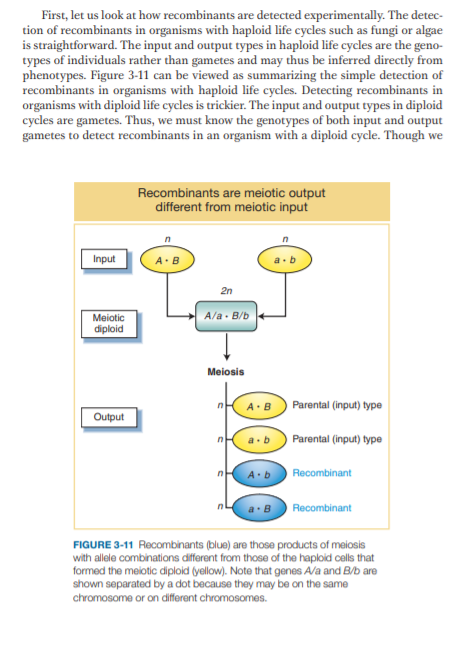First, let us look at how recombinants are detected experimentally. The detec- tion of recombinants in organisms with haploid life cycles such as fungi or algae is straightforward. The input and output types in haploid life cycles are the geno- types of individuals rather than gametes and may thus be inferred directly from phenotypes. Figure 3-11 can be viewed as summarizing the simple detection of recombinants in organisms with haploid life cycles. Detecting recombinants in organisms with diploid life cycles is trickier. The input and output types in diploid cycles are gametes. Thus, we must know the genotypes of both input and output gametes to detect recombinants in an organism with a diploid cycle. Though we Recombinants are meiotic output different from meiotic input Input A.B a.b 2n Meiotic diploid A/a B/b Meiosis A.B Parental (input) type Output Parental (input) type A. Recombinant Recombinant FIGURE 3-11 Recombinants (blue) are those products of meiosis with allele combinations different from those of the haploid cells that formed the meiotic diploid (yellow). Note that genes A/a and B/b are shown separated by a dot because they may be on the same chromosome or on different chromosomes.
First, let us look at how recombinants are detected experimentally. The detec- tion of recombinants in organisms with haploid life cycles such as fungi or algae is straightforward. The input and output types in haploid life cycles are the geno- types of individuals rather than gametes and may thus be inferred directly from phenotypes. Figure 3-11 can be viewed as summarizing the simple detection of recombinants in organisms with haploid life cycles. Detecting recombinants in organisms with diploid life cycles is trickier. The input and output types in diploid cycles are gametes. Thus, we must know the genotypes of both input and output gametes to detect recombinants in an organism with a diploid cycle. Though we Recombinants are meiotic output different from meiotic input Input A.B a.b 2n Meiotic diploid A/a B/b Meiosis A.B Parental (input) type Output Parental (input) type A. Recombinant Recombinant FIGURE 3-11 Recombinants (blue) are those products of meiosis with allele combinations different from those of the haploid cells that formed the meiotic diploid (yellow). Note that genes A/a and B/b are shown separated by a dot because they may be on the same chromosome or on different chromosomes.
Human Anatomy & Physiology (11th Edition)
11th Edition
ISBN:9780134580999
Author:Elaine N. Marieb, Katja N. Hoehn
Publisher:Elaine N. Marieb, Katja N. Hoehn
Chapter1: The Human Body: An Orientation
Section: Chapter Questions
Problem 1RQ: The correct sequence of levels forming the structural hierarchy is A. (a) organ, organ system,...
Related questions
Topic Video
Question
In Figure 3-11, if the input genotypes were a • B and A • b,
what would be the genotypes colored blue?

Transcribed Image Text:First, let us look at how recombinants are detected experimentally. The detec-
tion of recombinants in organisms with haploid life cycles such as fungi or algae
is straightforward. The input and output types in haploid life cycles are the geno-
types of individuals rather than gametes and may thus be inferred directly from
phenotypes. Figure 3-11 can be viewed as summarizing the simple detection of
recombinants in organisms with haploid life cycles. Detecting recombinants in
organisms with diploid life cycles is trickier. The input and output types in diploid
cycles are gametes. Thus, we must know the genotypes of both input and output
gametes to detect recombinants in an organism with a diploid cycle. Though we
Recombinants are meiotic output
different from meiotic input
Input
A.B
a.b
2n
Meiotic
diploid
A/a B/b
Meiosis
A.B
Parental (input) type
Output
Parental (input) type
A.
Recombinant
Recombinant
FIGURE 3-11 Recombinants (blue) are those products of meiosis
with allele combinations different from those of the haploid cells that
formed the meiotic diploid (yellow). Note that genes A/a and B/b are
shown separated by a dot because they may be on the same
chromosome or on different chromosomes.
Expert Solution
This question has been solved!
Explore an expertly crafted, step-by-step solution for a thorough understanding of key concepts.
Step by step
Solved in 2 steps

Knowledge Booster
Learn more about
Need a deep-dive on the concept behind this application? Look no further. Learn more about this topic, biology and related others by exploring similar questions and additional content below.Recommended textbooks for you

Human Anatomy & Physiology (11th Edition)
Biology
ISBN:
9780134580999
Author:
Elaine N. Marieb, Katja N. Hoehn
Publisher:
PEARSON

Biology 2e
Biology
ISBN:
9781947172517
Author:
Matthew Douglas, Jung Choi, Mary Ann Clark
Publisher:
OpenStax

Anatomy & Physiology
Biology
ISBN:
9781259398629
Author:
McKinley, Michael P., O'loughlin, Valerie Dean, Bidle, Theresa Stouter
Publisher:
Mcgraw Hill Education,

Human Anatomy & Physiology (11th Edition)
Biology
ISBN:
9780134580999
Author:
Elaine N. Marieb, Katja N. Hoehn
Publisher:
PEARSON

Biology 2e
Biology
ISBN:
9781947172517
Author:
Matthew Douglas, Jung Choi, Mary Ann Clark
Publisher:
OpenStax

Anatomy & Physiology
Biology
ISBN:
9781259398629
Author:
McKinley, Michael P., O'loughlin, Valerie Dean, Bidle, Theresa Stouter
Publisher:
Mcgraw Hill Education,

Molecular Biology of the Cell (Sixth Edition)
Biology
ISBN:
9780815344322
Author:
Bruce Alberts, Alexander D. Johnson, Julian Lewis, David Morgan, Martin Raff, Keith Roberts, Peter Walter
Publisher:
W. W. Norton & Company

Laboratory Manual For Human Anatomy & Physiology
Biology
ISBN:
9781260159363
Author:
Martin, Terry R., Prentice-craver, Cynthia
Publisher:
McGraw-Hill Publishing Co.

Inquiry Into Life (16th Edition)
Biology
ISBN:
9781260231700
Author:
Sylvia S. Mader, Michael Windelspecht
Publisher:
McGraw Hill Education